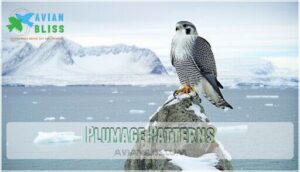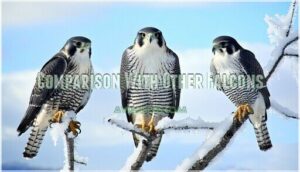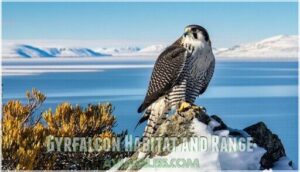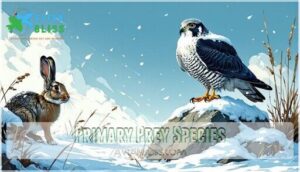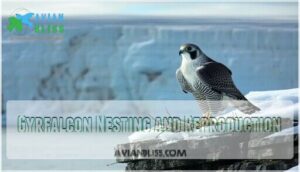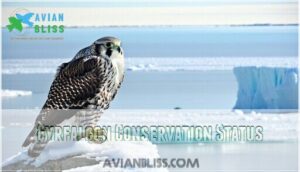This site is supported by our readers. We may earn a commission, at no cost to you, if you purchase through links.
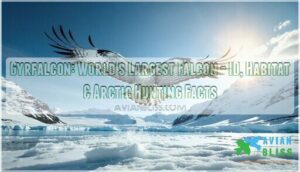
The gyrfalcon stands as nature’s ultimate aerial hunter, with powerful wings spanning up to four feet and razor-sharp talons that can crush prey instantly.
These remarkable birds display stunning plumage variations from pure white to charcoal black, each adapted to their specific Arctic territory.
Unlike other falcons that migrate south, gyrfalcons tough out brutal winters where temperatures plummet to minus 40 degrees.
Their hunting prowess is legendary – they can spot ptarmigan from miles away and dive at speeds exceeding 100 mph.
What makes these Arctic monarchs truly fascinating goes far beyond their impressive size and hunting skills.
Table Of Contents
- Key Takeaways
- Gyrfalcon Identification
- Gyrfalcon Habitat and Range
- Gyrfalcon Behavior and Social Structure
- Gyrfalcon Diet and Feeding Habits
- Gyrfalcon Nesting and Reproduction
- Gyrfalcon Conservation Status
- Gyrfalcon Biology and Ecology
- Gyrfalcon Movement and Migration
- Frequently Asked Questions (FAQs)
- Conclusion
Key Takeaways
- You’ll find the world’s largest falcon – Gyrfalcons dwarf other falcon species, with females reaching up to 4.6 pounds and wingspans of 63 inches, making them formidable Arctic predators that can tackle prey as large as Arctic hares.
- You’re looking at nature’s ultimate Arctic survivor – These remarkable birds don’t migrate like other raptors but stay put through brutal -40°F winters, using their heavily feathered feet, dense down insulation, and ability to store 300g of body fat for energy.
- You’ll witness three stunning color variations – Gyrfalcons display white, gray, or dark morphs that provide perfect camouflage against their Arctic terrain, with each form adapted to specific regional environments from Greenland’s white birds to Eurasia’s darker populations.
- You’re watching specialized hunters with unique techniques – Unlike high-speed diving peregrines, gyrfalcons excel at low-altitude horizontal pursuits across tundra, achieving 29% success rates through persistent chases that can last for miles and ambush tactics from elevated perches.
Gyrfalcon Identification
You’ll recognize a Gyrfalcon by its massive size and thick, powerful build that dwarfs other falcons.
These Arctic giants display variable plumage ranging from pure white with black speckles to dark gray with heavy barring, making identification challenging but rewarding.
Physical Characteristics
You’ll recognize a gyrfalcon by its massive build and thick, powerful body.
Sexual Dimorphism shows clearly – females dwarf males, matching Red-tailed Hawk size.
Wing Morphology features broad, pointed wings with relatively long tails.
Plumage Coloration varies dramatically across three morphs: pure white with black speckling, gray with intricate barring, or dark slate patterns.
This Size Comparison reveals nature’s largest falcon species.
Plumage Patterns
Gyrfalcons showcase three primary color morphs: white, gray, and dark.
Arctic masters wear their environment—pure white against snow, slate gray among cliffs, each morph perfectly suited for survival.
White morphs appear almost pure with minimal speckling, while gray morphs display pale upperparts with dark barring.
Dark morphs show slate-gray plumage with heavy spotting underneath.
Juvenile plumage runs darker and browner than adults across all morphs.
Regional variations create fascinating patterns – Greenland birds lean white, while Eurasian populations favor darker forms.
This genetic basis provides perfect camouflage against Arctic terrain.
They’re known for determined hunting behavior, rarely giving up on prey.
Size and Weight
When measuring these arctic giants, you’ll notice the Gyrfalcon’s impressive size dominates the falcon family.
Males stretch 19-24 inches with a wingspan reaching 48 inches, while females command 20-26 inches and broader wings up to 63 inches.
Sexual dimorphism creates dramatic weight variation – males weigh 1.8-3 pounds, but females pack 2.6-4.6 pounds of pure hunting power.
This body mass difference gives females advantage when tackling larger prey.
Size comparison reveals they’re bulkier than Peregrine Falcons, with thick, powerful builds.
Their robust measurements reflect arctic adaptations, where bigger means better survival.
Growth rates vary between sexes, with females developing into substantially larger hunters perfectly suited for their demanding northern territories.
Sexing Gyrfalcons
Determining sex proves challenging since both males and females display identical plumage morphs—white, gray, and dark variations occur in each sex.
Size dimorphism offers your best field clue: females weigh nearly twice as much as males and measure noticeably larger. Weight differences become obvious when pairs hunt together.
Behavioral sexing works during breeding season when males perform aerial displays. For definitive identification, genetic testing remains the gold standard.
They’re the world’s largest falcon.
Juvenile Characteristics
Looking at juvenile gyrfalcons reveals distinct differences from adults.
Juvenile plumage appears brownish overall with vertical streaking patterns on underparts.
Dark morph juveniles show lighter flight feathers contrasting with darker wings.
They display a weak mustache mark compared to adults’ bold facial patterns.
Color patterns can further aid identification.
During growth stages, juvenile behavior involves learning essential hunting skills under parental guidance before reaching independence.
Comparison With Other Falcons
When you’re falcon spotting, size comparison reveals gyrfalcons dwarf Peregrine Falcon and Prairie Falcon counterparts.
These arctic giants boast broader wings and longer tails than their speedier relatives. While peregrines dive-bomb prey at breakneck speeds, gyrfalcons prefer low-altitude pursuits across tundra.
Plumage differences show gyrfalcons’ variable white-to-gray morphs versus peregrines’ consistent slate-blue backs. Habitat overlap occurs in northern regions where both species hunt ptarmigan and waterfowl.
Gyrfalcon Habitat and Range
You’ll find gyrfalcons in the harsh, treeless landscapes of the Arctic tundra, where they’ve mastered life in one of Earth’s most challenging environments.
These powerful hunters also inhabit coastal cliffs, alpine regions, and northern forests across Alaska, Canada, Greenland, and northern Europe and Asia.
Arctic and Alpine Tundra
You’ll discover gyrfalcons thriving across Arctic tundra’s harsh landscape, where permafrost impact shapes their hunting grounds.
These powerful raptors dominate cliff nesting sites throughout the Arctic, coping with climate vulnerability with remarkable adaptation.
Key tundra features supporting gyrfalcons:
- Tundra vegetation provides cover for ptarmigan prey
- Arctic foodwebs sustain year-round hunting opportunities
- Human encroachment remains minimal in remote regions
Treeless Areas and Northern Forests
Beyond the Arctic tundra, gyrfalcons master Tundra Biomes where trees can’t survive.
These northern forest edges offer prime hunting grounds as Forest Encroachment creates Habitat Overlap zones.
Resource Availability peaks where open spaces meet scattered vegetation.
Climate Effects shift these boundaries, but gyrfalcons adapt quickly.
They patrol coasts and treeless valleys, capitalizing on ptarmigan and small mammals traveling between habitats.
Coastal Regions and Islands
Thriving along Arctic coasts and remote archipelagos, gyrfalcons capitalize on abundant marine prey and strategic cliff habitats.
These coastal hunting grounds provide year-round opportunities, while island nesting sites offer protection from ground predators.
Seacoasts become essential wintering areas where gyrfalcons adapt their hunting strategies to exploit diverse prey populations.
- Island nesting provides predator-free breeding sites
- Marine prey creates reliable food sources
- Cliff habitats offer ideal perching and nesting spots
- Archipelago life supports stable gyrfalcon populations
Breeding and Nesting Sites
You’ll find gyrfalcons nesting on remote cliff ledges across Arctic landscapes.
These apex predators select nesting sites with protective overhangs, creating minimal scrapes for their eggs.
Nest Site Selection prioritizes safety and hunting access.
Clutch Size typically ranges from 2-5 eggs, with Incubation Period lasting around 35 days.
Parental Care guarantees Nesting Success through fierce territorial defense.
Many people have found success using a specialized nesting box to encourage nesting.
| Nesting Feature | Specification | Survival Advantage |
|---|---|---|
| Cliff Height | 50-500+ feet | Predator protection |
| Clutch Size | 2-5 eggs | Ideal resource allocation |
| Incubation Period | 35 days | Proper chick development |
| Site Reuse | Multiple years | Energy conservation |
| Territory Size | 5-25 square miles | Adequate prey availability |
Wintering Grounds and Migration Patterns
These arctic giants don’t always migrate—many stay put if prey’s abundant.
When they do travel, you’ll spot them across diverse winter habitats from northern U.S. grasslands to sea ice platforms.
Key Migration Patterns:
- Migration Triggers – Food availability drives movement more than temperature changes
- Winter Habitats – Open tundra, coasts, agricultural lands, and pack ice areas
- Movement Ecology – Females and juveniles travel farther than territorial males
- Climate Impacts – Changing prey populations alter traditional wintering patterns
Gyrfalcon Behavior and Social Structure
You’ll discover that gyrfalcons are surprisingly complex social creatures despite their reputation as solitary hunters.
These Arctic giants display fascinating behaviors from their aggressive territorial displays to their surprisingly tender pair bonding rituals during breeding season.
Hunting Techniques and Strategies
You’ll witness incredible hunting techniques as gyrfalcons dominate Arctic skies.
Arctic giants turn tundra into their personal hunting arena with unmatched aerial dominance.
These masters employ adaptable techniques that make them apex predators.
Their attacking style involves shallow stoops and zig-zag pursuit rather than steep dives.
During high-speed pursuit, they’ll chase quarry for miles using powerful wingbeats and impressive endurance.
Their prey pursuit strategy includes surprise-and-flush tactics, flying low to startle ptarmigan from cover.
Ambush tactics from elevated perches allow sudden strikes on unsuspecting prey.
Hunting flight patterns adapt to terrain—they’ll ridge-hop to exploit updrafts or cruise valleys for better interception angles.
Many factors go into successful capture strategies for these birds.
Food caching near nests guarantees security during breeding season.
Their prey seizure involves climbing above targets before striking with slashing talons.
Success rates reach 29% through flexible hunting strategies that switch between aerial chases and ground attacks.
Prey Selection
Territorial Behavior and Aggression
You’ll witness aggressive hunters defending their turf with dominance displays and aerial combat.
Territorial gyrfalcons establish spatial distribution through intraspecific aggression, creating a social hierarchy where dominant pairs claim prime real estate.
Resource competition drives fierce territory defense, with these apex predators patrolling boundaries like feathered sentries guarding their Arctic kingdom.
Mating and Pair Bonding
You’ll witness fascinating courtship rituals when gyrfalcons select mates.
These arctic hunters perform aerial displays, mutual preening, and food exchanges during mate selection.
Pair bond duration typically lasts one breeding season, though some pairs reunite annually.
Fidelity factors include territory quality and breeding success.
Divorce rates remain low when partners successfully raise young together.
Nesting and Breeding Habits
You’ll notice Gyrfalcons prefer cliff ledges for nesting, often recycling old raven nests.
Females lay 2-5 eggs during breeding season, handling most egg incubation duties over five weeks.
Both parents provide parental care, teaching survival skills that boost breeding success.
Their nest site selection focuses on wind protection in harsh Arctic conditions.
They choose locations based on shelter and safety.
Solitary Behavior and Interactions With Other Birds
You’ll discover gyrfalcons are territorial loners, rarely tolerating other birds near their hunting grounds.
These Arctic apex predators defend vast territories through aggressive avian communication and displays.
Solitary hunting defines their lifestyle, yet they’ll engage in fierce interspecies competition with ravens, eagles, and other raptors.
Their social tolerance emerges only during breeding season, otherwise maintaining strict territorial defense against intruders seeking their prey.
Gyrfalcon Diet and Feeding Habits
You’ll discover that gyrfalcons are specialized predators with a diet centered around medium to large birds, particularly ptarmigan which can make up 40-75% of their food intake.
These powerful hunters also target seabirds, waterfowl, grouse, and mammals like Arctic hares, ground squirrels, and lemmings, adapting their feeding patterns to seasonal prey availability across their vast Arctic range, which showcases their ability to be powerful hunters.
Primary Prey Species
You’ll find gyrfalcons are specialized hunters with clear preferences. Ptarmigan Dominance drives their success, making up 40-75% of their diet where available.
These powerful raptors also target:
- Ptarmigan – primary prey across most Arctic regions
- Hares – Arctic hares provide substantial meals for larger females
- Waterfowl – seabirds and ducks during coastal hunting
- Ground squirrels – opportunistic catches in tundra habitats
- Lemmings – small but abundant rodent prey
Regional Variations and Lemming Influence shape local hunting patterns markedly.
Feeding Habits and Patterns
Gyrfalcons exhibit remarkable prey selection skills, targeting everything from ptarmigan to Arctic hares based on availability.
Their hunting frequency increases during breeding season, requiring 2-3 pounds daily.
These skilled predators practice food caching, storing excess prey near nest sites.
Their feeding behavior adapts to circumstances – they’ll hunt from perches or pursue prey in horizontal chases.
Dietary adaptations allow switching between bird and mammal targets seamlessly.
Seasonal and Geographic Variations in Diet
Seasonal diet shifts reveal the gyrfalcon’s remarkable adaptability.
Winter diet expands beyond summer’s ptarmigan-heavy menu to include waterfowl and mammals.
Summer prey focuses on abundant ptarmigan, comprising up to 75% of meals during breeding season.
Regional variations show coastal birds targeting seabirds while inland hunters prefer Arctic hares and ground squirrels.
Prey availability drives these diet shifts, with falcons switching from specialist to generalist hunting strategies when main food sources decline.
Comparison With Other Birds of Prey
When comparing gyrfalcons to other birds of prey, you’ll notice their unique position as apex Arctic hunters.
Unlike smaller falcons that rely on speed alone, gyrfalcons use their size advantage and power.
Key differences include:
- Size comparison: Gyrfalcons dwarf most raptors, matching Red-tailed Hawks in bulk while maintaining falcon agility
- Hunting styles: They pursue prey horizontally unlike peregrines’ high-speed dives, competing with goshawks for ground-based attacks
- Habitat overlap: Their Arctic range separates them from most raptor species, reducing direct competition
Gyrfalcon Nesting and Reproduction
You’ll find that gyrfalcons choose their nesting sites with remarkable precision, typically selecting cliff ledges that offer both protection and commanding views of their hunting grounds.
During their brief Arctic breeding season, these powerful raptors demonstrate fascinating parental behaviors that guarantee their offspring can survive in one of Earth’s harshest environments, which is a testament to their remarkable adaptability.
Nesting Sites and Structures
You’ll spot these Arctic masters choosing cliff ledges over construction projects.
They don’t build from scratch but claim rocky outcrops or commandeer abandoned raven nests. Smart nest reuse means less work, more hunting time.
| Nest Feature | Description |
|---|---|
| Primary Location | Rocky cliff ledges on Arctic barrens |
| Alternative Sites | Abandoned raven/eagle stick nests |
| Typical Height |
15-200 feet above ground level.
These nesting strongholds offer wind protection and predator deterrence across harsh Arctic landscapes.
Egg-Laying and Incubation
When you discover their breeding grounds, you’ll find female Gyrfalcons laying 3-4 cream-colored eggs with reddish-brown spots.
The incubation period spans 34-36 days, with both parents sharing duties in the harsh Arctic environment.
Clutch size varies from 1-5 eggs, each measuring about 2.2-2.4 inches.
Parental roles include the female handling most incubation while the male provides protection and food during nesting season.
Parenting and Chick-Rearing
After eggs hatch, both parents split Incubation Duties and Parental Defense responsibilities. The male typically handles hunting while the female guards the nest.
Chick Development progresses rapidly—these fluffy white juveniles grow fast on a steady diet of ptarmigan and hares. Feeding Frequency peaks at multiple meals daily during the breeding season. Parents demonstrate fierce protection, diving at intruders who threaten their young.
Fledgling Independence occurs around 45-50 days when chicks master flight skills. You can find a Gyrfalcon bird house online.
- Watching parent Gyrfalcons teach their young to hunt is nature’s masterclass in survival
- The fierce devotion these arctic giants show defending their nest will give you chills
- Seeing a juvenile take its first flight from a cliff ledge is pure magic
- The bond between Gyrfalcon families during fledging season touches something deep
- These powerful moments remind you why protecting arctic wilderness matters so much
Breeding Season and Mating Habits
In the harsh Arctic tundra, gyrfalcons begin their breeding season between April and June.
Males arrive first at traditional nesting cliffs, establishing territory and performing impressive aerial displays to attract females.
Courtship rituals include dramatic sky-dancing, prey deliveries, and ritualized bowing ceremonies that strengthen pair bonds.
Once mated, partners collaborate on nest site selection, typically choosing sheltered cliff ledges or abandoned raven nests.
The female lays 3-4 creamy white eggs speckled with reddish-brown markings.
Both parents share incubation duties for roughly 35 days, though females handle most responsibilities.
This synchronized breeding cycle guarantees chick development aligns perfectly with peak prey abundance during the brief Arctic summer, maximizing parental care success rates.
Conservation Status and Threats to Reproduction
Gyrfalcons face mounting reproductive challenges.
Climate change disrupts Arctic habitats, affecting egg viability and prey availability.
Human disturbance from mining threatens nest sites, while poaching for falconry persists.
Pollution effects reduce breeding success.
Their conservation status remains "Least Concern," but populations declined 43% since 1970.
Habitat destruction and nest disturbance compound these threats, making protection efforts essential.
Gyrfalcon Conservation Status
You’ll find that gyrfalcons face unique conservation challenges despite their remote Arctic habitat.
While their populations remain relatively stable compared to other raptors, climate change and human activities still threaten these magnificent birds in ways you mightn’t expect, highlighting the need for awareness of conservation challenges.
Global Population Trends
Scientists estimate population estimates of 16,900–70,000 mature gyrfalcons globally, with large uncertainty due to remote Arctic breeding success monitoring.
Canada hosts 43% of the world’s population.
Climate change threatens bird population stability through altered prey availability.
The IUCN Red List classifies their conservation status as Least Concern, though targeted conservation efforts address emerging climate impacts and minimal habitat loss.
These efforts are essential because habitat loss endangers birds.
Habitat Destruction and Fragmentation
Remote Arctic landscapes face mounting pressure as human activities threaten gyrfalcon strongholds.
These threats create a domino effect across their habitat:
- Oil drilling fragments pristine tundra habitat where prey availability sustains falcon populations
- Mining operations destroy coastal habitats and vital cliff-face nesting sites through direct excavation
- Human encroachment brings noise pollution that disrupts breeding behaviors and nesting success
- Infrastructure development creates barriers that fragment hunting territories and alter prey distribution patterns
Conservation strategies must address human activity impacts before climate change compounds these habitat losses.
Climate Change and Its Impacts
Climate threats hit gyrfalcons harder than most raptors.
You’ll see range contraction as Arctic ice melts, forcing these birds northward.
Prey availability drops when ptarmigan populations crash from warming temperatures.
Habitat shifts disrupt their breeding success, with wet conditions killing chicks.
Conservation strategies now focus on bird climate adaptation through nest protection and bird population monitoring to track environmental changes affecting bird species survival.
Human Disturbance and Pollution
Beyond climate change, human activities pose serious risks to gyrfalcon populations.
Industrial development disrupts their remote Arctic homes, while toxic chemicals accumulate through their food chain.
Pesticide exposure from agricultural runoff weakens reproduction and survival rates.
Lead poisoning from ammunition fragments in carrion creates deadly health impacts.
Noise pollution from aircraft and machinery disturbs nesting birds during critical breeding periods.
Key human threats include:
- Habitat degradation from mining and oil extraction
- Ecotourism effects disrupting sensitive nesting areas
- Climate impact altering prey distribution patterns
- Toxic chemical contamination through bioaccumulation
- Infrastructure development fragmenting territories.
Human threat mitigation requires balancing development with wildlife protection.
Conservation Efforts and Protection Laws
Wildlife conservation champions worldwide protect Gyrfalcons through thorough Legal Protections and international cooperation.
The IUCN lists them as "Least Concern," yet conservation efforts continue strengthening.
Population Monitoring tracks breeding success across Arctic territories.
Anti-Poaching Measures enforce strict falconry regulations preventing illegal capture.
Climate Resilience initiatives focus on Habitat Preservation through protected areas and parks, ensuring these magnificent raptors maintain their freedom to hunt across vast northern landscapes for generations.
| Conservation Body | Protection Level | Implementation Year |
|---|---|---|
| CITES | Appendix I/II | 1975 |
| Migratory Bird Treaty Act | Federal Protection | 1918 |
| Arctic Council | Habitat Agreements | 1996 |
| National Parks Service | Breeding Site Protection | Ongoing |
| International Falconry Association | Trade Regulations | 1968 |
Gyrfalcon Biology and Ecology
You’ll discover how gyrfalcons excel as apex predators through remarkable adaptations that let them thrive in Earth’s harshest environments.
These powerful hunters play a vital role in Arctic ecosystems while showcasing unique physiological traits that scientists continue to study, highlighting their ability as powerful hunters.
Adaptations to Arctic Environment
Gyrfalcons dominate Arctic landscapes through remarkable thermal regulation and camouflage plumage.
Their heavily feathered feet and thick down withstand temperatures to -50°C. Cold climate hunting succeeds because they’ve mastered Arctic prey adaptations—storing 300g of body fat for energy during storms.
White and gray plumage provides perfect camouflage against snow and rock. Breeding seasonality timing maximizes survival in harsh tundra ecosystems, making this Arctic bird of prey the ultimate Arctic wildlife survivor.
Physiological Characteristics and Traits
You’ll notice the gyrfalcon’s body showcases remarkable Size Dimorphism, with females weighing nearly twice as much as males.
Their dense Feather Insulation includes heavily feathered feet that protect against Arctic cold down to -50°C.
The gyrfalcon’s physiology reveals three key adaptations:
- Dense downy feathers with large aftershafts for maximum warmth
- Crop storage capacity holding several days’ worth of food
- Metabolic Rate adjustments during prey shortages for energy conservation
Ecological Role and Importance
As an apex predator, you’re the tundra keystone species that keeps Arctic ecosystems balanced.
Your hunting controls ptarmigan populations, creating ripple effects throughout the food web that scientists use to monitor ecosystem health.
- Arctic indicator – Your population reflects environmental changes
- Food web stability depends on your predatory role
- Bird conservation efforts focus on protecting your habitat
Interactions With Other Species
Throughout Arctic ecosystems, these massive raptors maintain complex relationships with prey and competitors.
Ptarmigan form their primary prey relationships, comprising up to 90% of their diet seasonally. They also hunt waterfowl, hares, and Sage Grouse when available.
Competition dynamics emerge with eagles over territory and nesting sites. Their ecosystem impact ripples through food webs, controlling prey populations while creating symbiotic relationships through nutrient cycling at coastal colonies.
Research and Study Methods
Scientists decipher Gyrfalcon secrets through cutting-edge research methods that reveal Arctic survival strategies.
Modern studies combine multiple approaches:
- Telemetry Tracking – GPS devices monitor movement patterns across vast territories
- Conservation Genomics – DNA analysis maps population genetics and adaptation mechanisms
- Behavioral Observation – Motion-activated cameras capture hunting and nesting behaviors
Genetic Analysis helps researchers understand bird taxonomy and evolutionary history.
Population Modeling uses data to predict bird population trends and dynamics.
These bird research techniques provide vital insights for bird monitoring programs, ensuring effective conservation of the world’s largest falcon species.
Many also participate in bird monitoring programs to enhance conservation efforts.
Gyrfalcon Movement and Migration
Unlike many Arctic birds, you won’t see gyrfalcons following predictable migration routes twice a year.
These powerful falcons move based on food availability rather than seasons, with some northern populations traveling hundreds of miles south while others stay put if prey remains abundant.
Migration Patterns and Routes
Gyrfalcons don’t follow strict Winter Movements like clockwork – their bird migration patterns respond to prey availability and harsh arctic conditions.
Some populations show strong Route Fidelity, returning to familiar bird migration routes year after year, while others wander based on Dispersal Triggers like food scarcity.
Climate Impacts increasingly disrupt traditional patterns.
- Watch massive wings slice through frigid arctic air during epic journeys
- Feel the raw power as these apex hunters navigate thousands of miles
- Experience nature’s ultimate freedom through their untamed wandering spirit
- Witness ancient Stopover Ecology traditions passed through generations
- Marvel at their mastery over harsh arctic tundra landscapes
Altitudinal and Geographic Movements
Beyond typical migration triggers, you’ll discover gyrfalcons make fascinating elevation changes throughout their arctic range.
Winter dispersal often drives these powerful hunters from high-altitude breeding cliffs down to lower elevations where prey remains accessible.
Climate influence shapes their vertical movements—harsh weather forces range expansion into new territories.
These elevation changes aren’t random; they follow food availability across the arctic tundra, demonstrating remarkable adaptability in bird migration patterns, which is influenced by climate influence and results in range expansion.
Dispersal and Wanderings
Young birds break free from their birthplace, setting out on epic journeys across the Arctic landscape. Juvenile Dispersal drives these wanderers hundreds of miles from home as they search for unclaimed territory. Winter Movements push them toward coasts and southern habitat where prey remains abundant. Ranging Behavior reveals their incredible adaptability across diverse wintering grounds.
- Migration Triggers: Food scarcity and harsh weather drive southward journeys
- Dispersal Factors: Territory competition forces young birds to explore new range
- Arctic Adventures: Some birds wander thousands of miles from breeding sites
These movements aren’t random—they’re survival strategies that showcase the gyrfalcon’s remarkable ability to thrive across vast northern landscapes.
Habitat Use and Selection During Migration
Like a GPS for aerial predators, Migration Habitat selection reveals Gyrfalcon survival instincts.
These Arctic masters choose Stopover Sites based on Resource Availability and prey density. Climate Influence shapes their route decisions, while Route Fidelity guarantees they’ll return to proven locations.
Migration Routes
Stopover Habitats
Habitat Fidelity
Wintering Grounds
Satellite tracking discloses their strategic habitat choices across Arctic regions.
Conservation Implications of Movement Patterns
Understanding gyrfalcon movement patterns reveals critical insights for effective conservation planning.
When you track these Arctic hunters, you’ll discover how their migrations expose vulnerabilities requiring targeted protection strategies.
Key conservation insights include:
- Migration threats from habitat connectivity loss and climate impacts affect genetic diversity across populations
- Bird population monitoring programs use movement data to identify critical stopover sites needing immediate protection
- Bird habitat conservation efforts must address shifting ranges as gyrfalcons adapt to changing Arctic conditions
These conservation strategies strengthen bird conservation efforts for long-term bird species conservation success.
Frequently Asked Questions (FAQs)
What is a gyrfalcon Falcon?
A falcon emerges as nature’s aerial assassin, and you’ll find the gyrfalcon reigns supreme as the largest falcon species.
You’re witnessing an arctic hunter with powerful wings, variable plumage, and unmatched prowess in open tundra landscapes.
How much does a gyrfalcon weigh?
You’ll find that gyrfalcons pack serious weight – males tip the scales at 8-3 pounds, while females dominate at 6-6 pounds, making them the heavyweight champions of the falcon world.
Where do gyrfalcons live?
You’ll discover gyrfalcons across Arctic regions of North America, Europe, and Asia. They inhabit tundra, coastal cliffs, mountains, and open landscapes where hunting opportunities abound year-round.
What color is a gyrfalcon?
Ever wondered what nature’s Arctic warrior looks like?
You’ll spot gyrfalcons in stunning white, gray, or dark brown plumage – with gray being most common in North America, creating perfect camouflage against snowy tundra.
What is a gyrfalcon Raptor?
You’ll discover raptors are birds of prey with sharp talons and hooked beaks.
A gyrfalcon’s the largest falcon species, weighing up to 6 pounds with powerful wings spanning five feet for arctic hunting dominance.
What does a gyrfalcon do?
Picture yourself soaring through Arctic skies, scanning frozen landscapes below.
You’ll hunt birds like ptarmigan and small mammals, using powerful dives and low-speed chases.
You’re an apex predator, caching extra prey near your cliff nest during breeding season.
Why is it called a Gyrfalcon?
You’ll master the name’s origin by tracing its medieval roots.
"Gyrfalcon" comes from Old French "girfauc," combining Proto-Germanic "ger" meaning vulture with Latin "falco" meaning hawk, creating a perfect description for this magnificent Arctic hunter.
What are gyrfalcons known for?
Like arctic royalty ruling frozen kingdoms, you’ll recognize gyrfalcons as the world’s largest falcons.
They are renowned for their incredible hunting prowess, striking color variations from pure white to dark gray.
They also have a legendary status in medieval falconry as prized birds of kings.
Are gyrfalcons native to Iceland?
Yes, you’ll find these magnificent Arctic hunters are absolutely native to Iceland.
The Gyrfalcon is a native species to Iceland, having called the island home since the last Ice Age ended approximately 10,000 years ago.
Where are Gyrfalcons found?
You’ll find these magnificent raptors across arctic regions of North America, Europe, Asia, Greenland, and Iceland. They inhabit tundra, cliffs, and open landscapes, migrating south during winter.
Conclusion
Witnessing the world’s apex aerial predator requires patience and understanding.
You’ve discovered how the gyrfalcon’s remarkable adaptations enable survival in extreme Arctic conditions.
These impressive raptors demonstrate nature’s engineering through specialized plumage, powerful hunting techniques, and resilient breeding strategies.
Their conservation depends on protecting vast Arctic habitats from climate change and human interference.
Whether you’re spotting white morphs against snowy landscapes or observing their incredible hunting displays, gyrfalcons represent wilderness at its most magnificent and untamed.
- https://fieldguide.mt.gov/speciesDetail.aspx?elcode=abnkd06080
- https://www.birdweb.org/birdweb/bird/gyrfalcon
- https://animaldiversity.org/accounts/Falco_rusticolus/
- https://www.secretatlas.com/handbook/wildlife-and-nature-guides/arctic/gyrfalcon
- https://raptor.umn.edu/about-raptors/raptors-north-america/gyrfalcon


